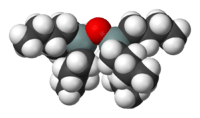Tributyltin oxide
| Tributyltin oxide | |
|---|---|
| | |
 | |
| Identifiers | |
| CAS number | 56-35-9 |
| PubChem | 16682746 |
| ChemSpider | 10218152 |
| KEGG | C18149 |
| ChEMBL | CHEMBL511667 |
| Jmol-3D images | {{#if:CCCC[Sn](CCCC)(CCCC)O[Sn](CCCC)(CCCC)CCCC|Image 1 |
| |
| |
| Properties | |
| Molecular formula | C24H54OSn2 |
| Molar mass | 596.112 |
| Melting point | -45 °C |
| Boiling point | 180 °C at 2 mm Hg |
| Solubility in water | 0.002 g/100 mL |
| Hazards | |
| R-phrases | R21 R25 R36/38 R48/23/25 R50/53 |
| S-phrases | S36/37/39 S45 S60 S61 |
| Except where noted otherwise, data are given for materials in their standard state (at 25 °C (77 °F), 100 kPa) | |
| Infobox references | |
Tributyltin oxide (TBTO), or bis(tri-n-butyltin)oxide, is an organotin compound chiefly used as a biocide (fungicide and molluscicide), especially a wood preservative. Its chemical formula is C24H54OSn2. It has the form of a thin, colorless to pale yellow liquid with melting point -45 °C, boiling point 180 °C, and slight water solubility (20 ppm). It is combustible and soluble in organic solvents.
It is available under names AW 75-D, Bio-Met TBTO, Biomet, Biomet 75, BTO, Butinox, C-SN-9, Hexabutyldistannoxane and others.
Tributyltin oxide is a potent skin irritant.
Tributyltin compounds had been used as marine anti-biofouling agents. Concerns over toxicity of these compounds (some reports describe biological effects to marine life at a concentration of 1 nanogram per liter) have led to a worldwide ban by the International Maritime Organization.[1] It is now considered a severe marine pollutant and a Substance of very high concern by the EU.
References
- ↑ "Focus on IMO - Anti-fouling systems". International Maritime Organisation.